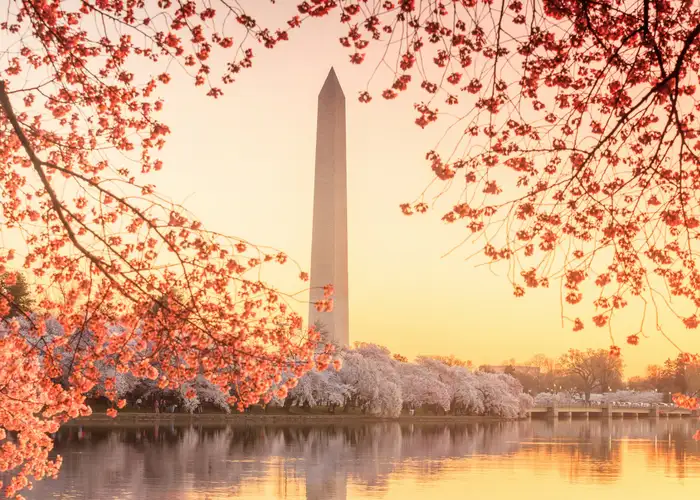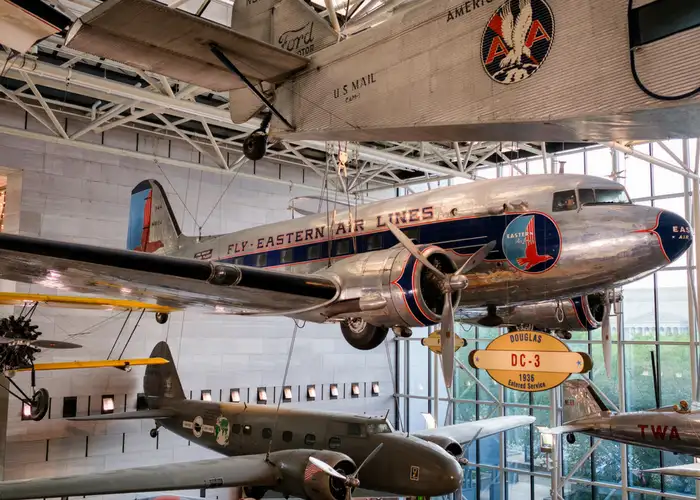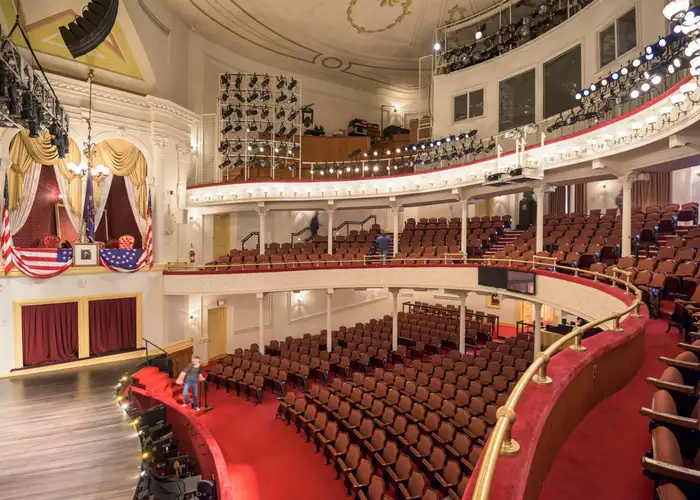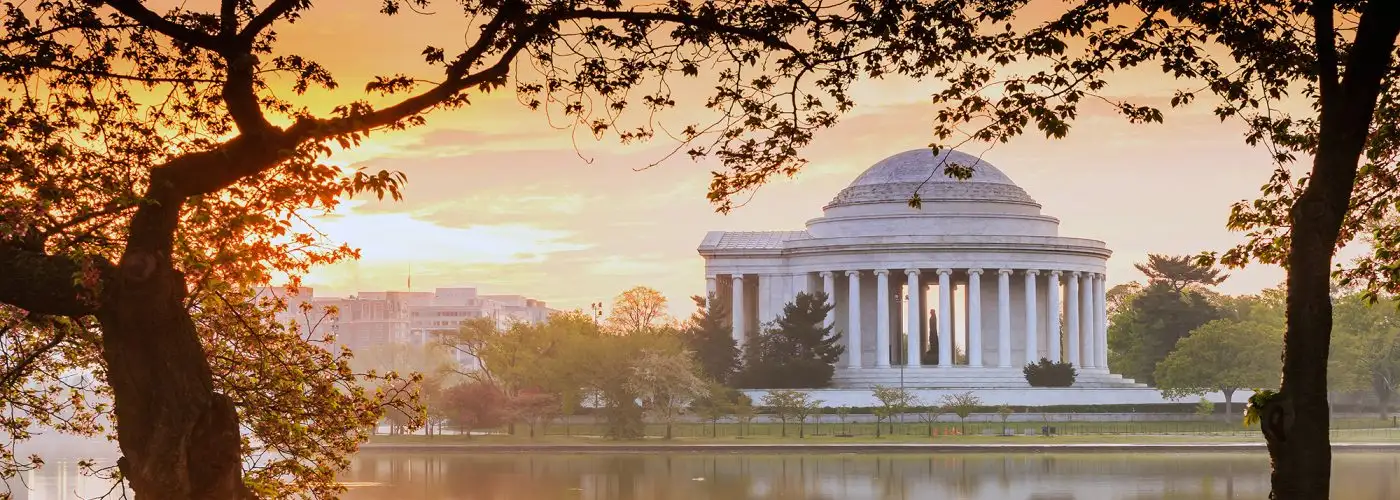To many visitors, Washington, D.C. is another world—one where politicians are like rock stars and where even the most cynical citizens feel patriotic at the sight of the Capitol Building lit up at night. Washington is also a place where history happens before your eyes. You can visit the Senate and House chambers to see government in action. You can stand where Martin Luther King, Jr., delivered his “I Have a Dream” speech. You can visit dozens of monuments dedicated to the people and events who shaped this country. But history and politics aren’t the only Washington, D.C. attractions worth seeing.
Washington, D.C. Attractions
You could spend your entire visit just exploring the 19 museums of the Smithsonian, all free of charge. And don’t forget the city’s green spaces; join the local joggers and dog-walkers along the National Mall, or visit in early spring to see the fluffy pink blooms of the cherry trees along the Tidal Basin, a gift from Japan in 1912. For the essential places to visit in Washington, D.C., keep reading—and start planning.
U.S. Capitol

The U.S. Capitol is the seat of the legislative branch of the U.S. government. If you would like to visit the House or Senate chambers to see the politicians in action—highly recommended—write or call your Congressperson’s office before your trip for passes. You may be able to get passes at the last minute by visiting his or her office in person (a directory near the ticket booth will tell you where your representative’s office is located). International visitors can visit the galleries by stopping by the House and Senate Appointment Desks in the Capitol Visitor Center. To see the rest of the majestic building, take a free guided tour, not including the chambers, with guides outlining the history and architecture.
National Mall

Monuments and memorials are some of the most vital things to see in Washington D.C. Most are clustered in and around the National Mall, which runs about two miles from the Lincoln Memorial to the U.S. Capitol, with plenty of grassy area in between (the setting for festivals, Frisbee matches, rallies, picnics, and protests). The space was planned by original Washington designer Pierre L’Enfant as a grand boulevard and place for remembrance, observance, and protest.
Lincoln Memorial

The Lincoln Memorial was dedicated in 1922 and overlooks the Reflecting Pool, the Washington Monument, and the U.S. Capitol. Inside the Greek temple design, with its 36 columns, is a 19-foot marble statue of the 16th president. The memorial was also an important backdrop for the Civil Rights Movement, including Martin Luther King, Jr.’s “I Have a Dream” speech.
Jefferson Memorial

Located in a structure reminiscent of the Pantheon, the Jefferson Memorial displays a 19-foot bronze statue of the third President of the United States. The memorial was dedicated in 1943, and includes one of Jefferson’s favorite design elements, the rotunda, in its structure.
Washington Monument

The Washington Monument stands 555 feet above the Mall, an Egyptian-style obelisk completed in 1884 as a tribute to George Washington. Around the base are 50 flagpoles representing each state. Access to the top is closed until spring 2019 for elevator modernization.
Other Memorials and Monuments

Other memorials and monuments of note include the Martin Luther King, Jr. Memorial, located along the Tidal Basin; the powerful Vietnam Veterans Memorial, near Constitution Gardens; and the National World War II Memorial, on the eastern end of the Reflecting Pool.
White House

The White House has been the home of every U.S. president since John Adams. The White House currently offers tours only for those who make advance reservations through a member of Congress. You can apply up to three months before your trip.
Smithsonian Museums

The 19 museums of the Smithsonian Institution are free of charge and can easily occupy several days of Washington, D.C. sightseeing. Which you chose to visit is up to your personal interests, but I highly recommend the National Air and Space Museum, where you’ll find such icons of flight as the original Wright Flyer, the Spirit of St. Louis, SpaceShipOne, and the Apollo 11 command module.
The newest Smithsonian institution—and one of the hottest Washington, D.C. attractions right now—is the National Museum of African American History and Culture, which offers a moving, comprehensive overview from the arrival of the first African slaves to the present day. Check the website for ticket policies, as you may need to book in advance.
National Zoo

The giant pandas are the main draw at the National Zoo, also part of the Smithsonian system. In addition, there are thousands of other exotic animals and a re-creation of the Amazon rainforest.
Art Museums

The National Portrait Gallery and American Art Museum share a building (at 8th and F Streets NW) constructed in 1836 as the U.S. Patent Office. The Portrait Gallery highlights famous Americans from George Washington (the famous “Landsdowne” portrait) to Marilyn Monroe and Shaquille O’Neal; one newer addition is a portrait of President Obama. The American Art Museum boasts one of the largest collections of American art in the world, including works by Edward Hopper and Georgia O’Keeffe.
Washington, D.C. attractions for art lovers include the free National Gallery of Art, which has in its West Wing a collection of international masterpieces from the 13th to 19th centuries and in its East Wing a collection of modern and contemporary art. The Phillips Collection was the first modern art museum in the U.S., and is where you’ll find Renoir’s “Luncheon of the Boating Party,” as well as works by Van Gogh, Picasso, Matisse, O’Keeffe, Degas, and more.
United States Holocaust Memorial Museum

The United States Holocaust Memorial Museum may be the single most rewarding and emotionally harrowing of Washington, D.C. attractions. Plan a half day to see the museum and then recover from the devastating exhibits on display. The museum traces the history of the Jewish persecution under the Nazis from 1933 to 1945 through artifacts, photos, and oral histories. From March through August, timed passes are required to view the permanent exhibition, with free passes given out on a first-come, first-served basis. You can avoid the lines by purchasing passes on the museum’s site in advance for a small fee.
Kennedy Center

For a night out, see what’s on at the John F. Kennedy Center for the Performing Arts, the nation’s top performing arts facility. Even if you don’t want to spring for a ticket, there are free theatrical and musical performances offered daily at 6:00 p.m.
International Spy Museum

If you’re looking for Washington, D.C. attractions that you won’t find anywhere else, visit the unique International Spy Museum. It explores the craft, practice, history, and role of espionage, and serves up an impressive collection of espionage-related artifacts—like lipstick guns and cufflink compasses. Interactive experiences include Operation Spy, which combines special effects and live action to help participants feel what it’s like to be a spy. Lines to get in can be long during busy tourist seasons, so book your tickets in advance (for an extra fee) to avoid the wait.
Ford’s Theatre

You can still catch a play at Ford’s Theatre, where President Lincoln was assassinated. Or just come by for a tour of this historic site—you’ll walk through the theater itself as well as the house across the street where Lincoln died.
Cathedral and Basilica

There are several two religious Washington, D.C. attractions worth noting. The Washington National Cathedral has not only a stunning stained-glass windows and extensive needlepoint collection, but also a gargoyle in the shape of Darth Vader (you’ll need binoculars to see it). Another church worth a visit is the Basilica of the National Shrine of the Immaculate Conception, the largest Roman Catholic Church in the U.S.
Library of Congress

Bibliophiles won’t want to miss a visit to the Library of Congress, the world’s largest library. You can check out the historic building’s grand architecture and look out over the beautiful Main Reading Room. Free guided tours are available.
Mount Vernon

Mount Vernon, George Washington’s mansion and estate, overlooks the Potomac River about 16 miles from the city. George and Martha lived in the mansion after their marriage in 1759. You can visit the 21-room mansion house and more than a dozen outbuildings including the slave quarters, stables, and kitchen, as well as a working farm. The gardens offer a lovely setting for a stroll. Just three miles away, George Washington’s Distillery and Gristmill is open seasonally for a look at the first president’s entrepreneurial spirit.
More from SmarterTravel:
- Washington, D.C. Travel Guide
- 8 Fun Things to Do in Washington, D.C.
- 7 Washington, D.C. Museums You Haven’t Heard Of
- 9 Best Day Trips from Washington, D.C.
- 9 Best Hotels in Washington, D.C.
- 10 Best Cheap Hotels in Washington, D.C.
- 6 Famous Hotels in Washington, D.C.
- 9 Best Restaurants in Washington, D.C.
- The 10 Best Washington, D.C. Food Trucks
- The 10 Best Spots for Brunch in Washington, D.C.
- What to Pack for Washington, D.C.
- What to Wear in Washington, D.C.
[viator_tour destination=”657″ type=”3-mod”]
—Original reporting by Fran Golden
We hand-pick everything we recommend and select items through testing and reviews. Some products are sent to us free of charge with no incentive to offer a favorable review. We offer our unbiased opinions and do not accept compensation to review products. All items are in stock and prices are accurate at the time of publication. If you buy something through our links, we may earn a commission.
Related
Top Fares From Wichita, KS
Today's Top Travel Deals
Brought to you by ShermansTravel
Shop and Save with Country Inns...
Patricia Magaña
 Hotel & Lodging Deals
Hotel & Lodging Deals
$229 -- Chicago: Discounted Rates and...
Francesca Miele
 Hotel & Lodging Deals
$229+
Hotel & Lodging Deals
$229+
$188 -- Honolulu: Save on Oceanview...
Abigail Lamay
 Hotel & Lodging Deals
$188+
Hotel & Lodging Deals
$188+




